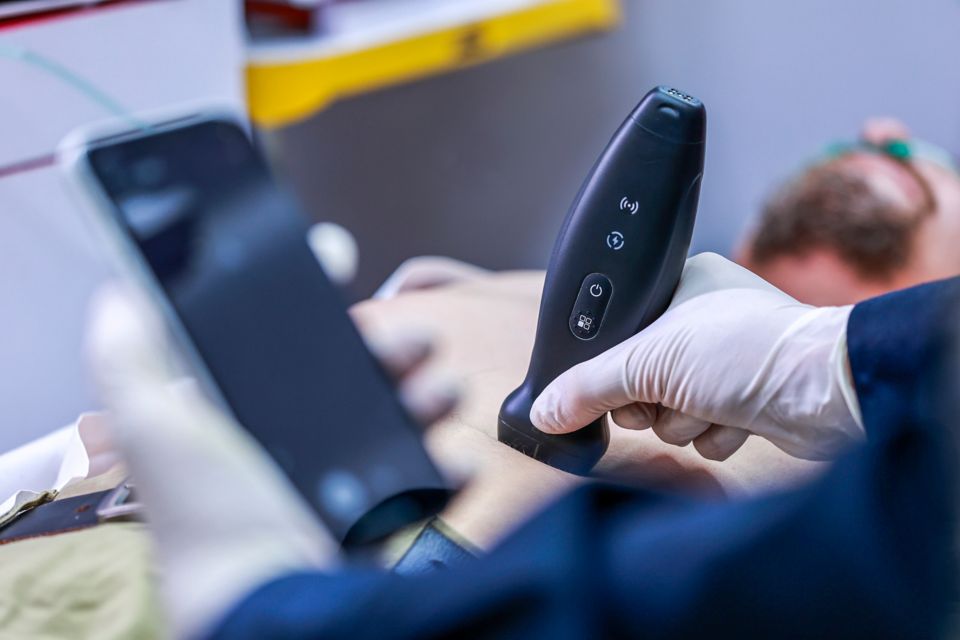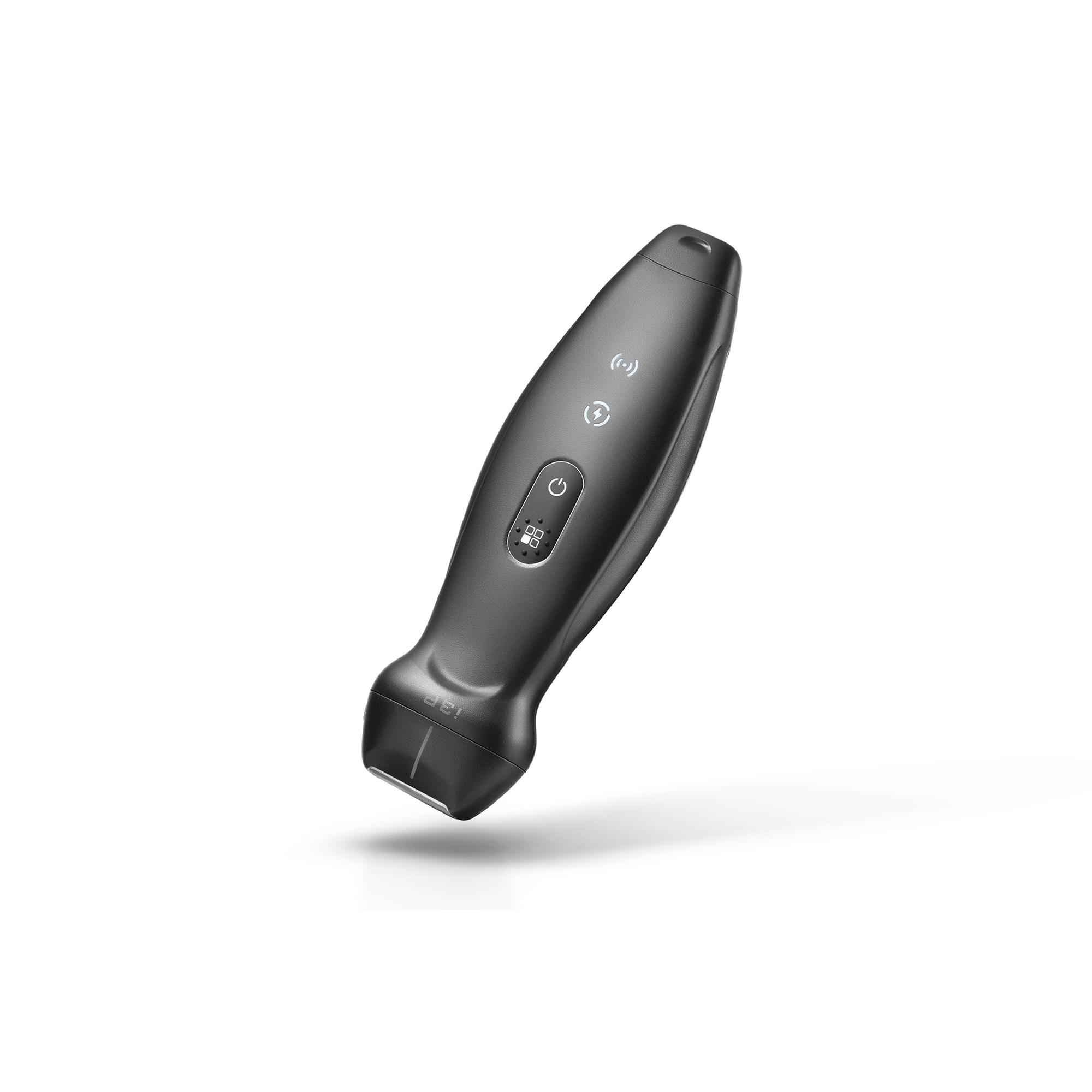Point of Care Ultrasound (POCUS) is a versatile diagnostic tool that empowers clinicians to integrate ultrasound imaging directly into patient assessment and intervention, regardless of the setting – whether at the bedside, in the field, or during patient transport. This immediate access to medical imaging can help expedite the diagnosis and treatment process, an advantage that is particularly significant in urgent cases. As a result, POCUS can not only enhance the effectiveness of medical treatment but also significantly improve patient outcomes. Additionally, the use of POCUS has the potential to lower healthcare costs due to a more efficient use of time and resources.
As ultrasound continues to become the imaging modality of choice for a variety of clinicians, portable devices, such as handheld ultrasound, are gaining popularity due to their ease-of-use and ability to quickly capture images at the point of care. This blog aims to discuss the different applications of handheld ultrasound for POC and the advantages and limitations.

How Does Handheld Ultrasound Work?
Ultrasound creates images of anatomical structures by sending high frequency sound waves into the body via an ultrasound transducer. These sound waves reflect back from those internal structures and return to the transducer. These returning echos get translated into a two-dimensional image on the ultrasound system. Ultrasound systems also have the ability to use doppler to measure the velocity of blood and other moving structures. Some specialty transducers can produce 3D images or be used inside the body. Ultrasound is used in a wide variety of applications such as OB, Cardiac, Abdominal, and Musculoskeletal imaging to aid in diagnosing and treating patients.
What is Handheld Ultrasound?
Handheld ultrasound is a portable ultrasound consisting of a probe that can connect to a mobile device or a larger ultrasound machine to provide clinicians with real-time images at the point of care. Handheld ultrasound devices differ from other ultrasound devices because they tend to be compact and small enough to fit in a clinician’s pocket and can be taken virtually anywhere to capture patient images.

Benefits of Handheld Ultrasound in Point of Care Settings
Due to their size and functionality, handheld ultrasound devices offer many benefits to clinicians versus other larger portable ultrasound machines, some of which include:
Applications of Handheld Ultrasound in Point of Care Settings
Handheld ultrasound systems can be used in a variety of point of care settings, allowing clinicians from numerous clinical specialties to take real-time images of their patients quickly. Some examples of applications include:
- Emergency Medicine – Using handheld ultrasound systems in emergency settings can be potentially lifesaving to trauma patients as clinicians can quickly perform FAST, eFAST, and RUSH exams and quickly evaluate chest pain and other acute conditions requiring immediate intervention
- Critical Care – In critical care settings, handheld devices allow for a real-time assessment of cardiac function, fluid management, and evaluation of lungs while also providing procedural guidance for IVs, central lines, and ECMO cannulation
- Primary Care – Handheld ultrasound systems make it easier for primary care physicians to evaluate cardiac function and perform fetal checks without sending patients out for imaging elsewhere. Primary care physicians can also use handheld ultrasound to screen for abdominal aortic aneurysms and renal/bladder status
- Obstetrics and Gynecology – In the OB/GYN office, fetal health checks and fetal positioning can be captured accurately with handhelds, enabling clinicians to assess the fetus more quickly
- Musculoskeletal – Handhelds are optimal for scanning for musculoskeletal injuries, and procedural guidance for aspirations and pain injections
- Prehospital/EMS – Similarly to emergency medicine, handhelds enable EMS workers to scan patients to evaluate life-threatening conditions, such as trauma or chest pain before they are admitted to the emergency room, thus saving time and enabling emergency medicine clinicians to provide treatment faster once the patient is in their care.
Challenges and Limitations of Handheld Ultrasound
Although handheld ultrasound offers many advantages to clinicians and the patients they serve, these smaller, compact devices come with several limitations that should be addressed before using them for diagnosis:
- Dependence on user skill and interpretation – Whether imaging with a handheld or traditional ultrasound system, training in scanning and image interpretation is crucial to accurate diagnosis. Imaging with handheld ultrasound requires additional training, as the risk of overuse can lead to incidental findings. [1]Ensuring that physicians are trained only to scan when necessary, helps to mitigate false findings from newer and less experienced clinicians
- Limited scope of imaging – Currently, handheld ultrasound does not provide the same image quality as larger ultrasound systems, and advanced echo applications are lacking. Focused cardiac ultrasound can still be qualitatively performed with a handheld device; however, few current devices offer spectral Doppler capabilities or comprehensive measurement packages thus precluding their use for quantitative applications[2].
- Disinfection concerns – Like their larger counterparts, handheld ultrasound devices require rigorous disinfection between patients, necessitating a uniform protocol that all healthcare personnel should adhere to. However, a key advantage of handhelds, especially wireless ones, over other ultrasound systems is that they can more easily be covered with sterile sheaths during use. This practice significantly reduces the risk of cross-contamination and the spread of infectious diseases from patient to patient.[3] Please refer to your manufacturer’s IFU’s for approved cleaning methods and disinfectants.
- Technical limitations – While handheld ultrasound devices offer many benefits, it’s important to consider potential technical limitations. One of these is battery life; these devices typically run on rechargeable batteries that can power several examinations, but may not last the entire workday, depending on usage. Planning for battery recharging can be crucial in busy settings.

The Future of Handheld Ultrasound
Handheld ultrasound devices provide numerous benefits to clinicians and their patients. Utilizing handhelds in POCUS environments allows for rapid deployment of treatment and helps to improve patient outcomes. With ultrasound gaining more popularity as an imaging technique each year, handhelds will likely continue to increase in POCUS environments due to how affordable and portable they are. As mobile devices such as smartphones and tablets have become the norm over the past decade, handhelds will be an intuitive imaging option for newer and younger clinicians entering the field.
Although handhelds have some limitations, the technology behind these devices and the mobile apps that support them are constantly improving. Image quality and versatility on handhelds may not yet be comparable to larger, standard ultrasound systems, but advancements such as AI programs are helping to enhance these features.
Handhelds offer many enticing benefits to clinicians, and as the clinical and technical research behind these devices continues to progress, they will continue to improve, helping to bring clinicians closer to their patients.






